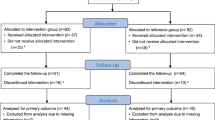Abstract
This study reports on the follow-up data of an integrated group program to reduce asthmatic symptoms. The 16 sessions included a comprehensive multibehavioral/desensitization retraining program and utilized EMG/Incentive inspirometer feedback to encourage slow diaphragmatic breathing in all situations. 17 out of 21 volunteers participated in the 15-month follow-up study. At the follow-up all subjects significantly reduced their EMG tension levels while simultaneously increasing their inhalation volumes. Subjects reported reductions in their asthma symptoms, medication use, emergency room visits, and breathless episodes.
Similar content being viewed by others
References
Cluss, P. A. (1986). Behavioral interventions as adjunctive treatments for chronic asthma.Progress in Behavioral Modification, 20 123–160.
Dahl, J., Gustafsson, D., & Melin, L. (1990). Effects of a behavioral treatment program on children with asthma.Journal of Asthma, 27(1), 41–46.
Peper, E. (1985). Hope for asthmatics.Somatics, V(2), 56–62.
Peper, E. (1988). Strategies to reduce the effort of breathing: Electromyographic and inspirometry biofeedback.Respiratory Psychophysiology (pp. 113–122). London: MacMillan Press, Ltd.
Peper, E. (1990).Breathing for health with biofeedback. Montreal: Thought Technology, Ltd.
Peper, E., Waddell, D., & Smith, K. (1987). EMG and incentive inspirometer (Voldyne) feedback to reduce symptoms in asthma.Biofeedback and Self-Regulation, 12(2 159.
Peper, E., & Waddell, D. (1987). Teaching diaphragmatic breathing with EMG and inhalation feedback to reduce asthmatic symptoms.Proceedings of the 8th annual meeting of the Society of Behavioral Medicine (pp. 32–33). Knoxville: SBM.
Peper, E., Smith, K., & Waddell, D. (1987). Voluntary wheezing versus diaphragmatic breathing and voldyne feedback: A clinical intervention in the treatment of asthma.Clinical Biofeedback and Health, 10(2), 83–88.
Roland, M., & Peper, E. (1987). Inhalation volume changes with inspirometer feedback and diaphragmatic breathing coaching.Clinical Biofeedback and Health, 10(2), 89–97.
Tibbetts, V., & Peper, E. (1988). Incentive inspirometer feedback for desensitization with asthmatic provoking triggers: A clinical protocol.Proceedings of the nineteenth annual Meeting of the Biofeedback Society of America (pp. 200–203). Wheat Ridge: BSA.
Author information
Authors and Affiliations
Additional information
We thank Ms. Michelle Roland, Kathy Smith, and Jeanne Charbonneau for their helpful assistance.
Rights and permissions
About this article
Cite this article
Peper, E., Tibbetts, V. Fifteen-month follow-up with asthmatics utilizing EMG/Incentive inspirometer feedback. Biofeedback and Self-Regulation 17, 143–151 (1992). https://doi.org/10.1007/BF01000104
Issue Date:
DOI: https://doi.org/10.1007/BF01000104




